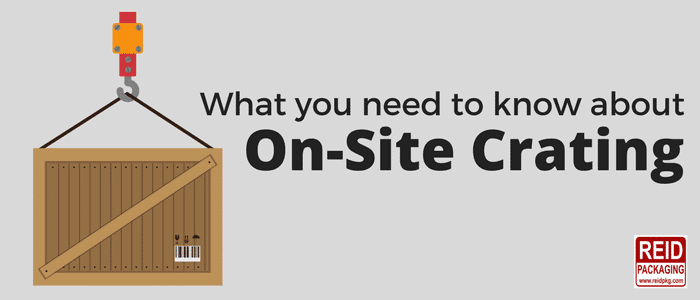On-Site Crating
This article at a glance:
- What is on-site crating, and why might it be the right choice for your job?
- Special challenges in on-site crating that we have learned to solve.
- Special considerations for doing ISPM-15-compliant on-site crating to prepare packages for export.
- Reid Packaging’s extensive on-site crating capabilities.
Here in Peachtree Corners, Georgia, we have a 60,000 square-foot, very well equipped facility for manufacturing industrial crates and corrugated boxes as well as for packaging valuable machinery, parts, and products. Walking through our shop gives you a sense of just how seriously we take crating. Our staff is working hard to build the perfect crate for each job — crates that protect machinery worth millions on harrowing journeys around the world.
But despite the high level of investment that we’ve made in our facility and equipment, we actually do a lot of our crating elsewhere. We call this on-site crating (on the site where the machinery is being housed). There are all kinds of reasons why freight would have to be crated on-site. Sometimes it is too fragile to be moved from its current location without protection, or it is being shipped overseas. Other times it is confidential, too large or too uniquely-shaped to load directly onto a truck. No matter the reason, we can come to your facility and take care of your crating needs.
What is On-Site Crating?
On-site crating refers to the jobs where we travel to your location with all the pre-assembled or kitted crating materials we need to secure, wrap, protect, preserve and skid or fully crate your equipment. It’s a service we have been offering for years and our clients are quite happy with the results that we get.
On-site crating capabilities include:
- custom wood crates
- custom corrugated containers
- moisture control (barrier bags and desiccants)
- ISPM-15 compliant export packaging
- mil spec compliance
- pallets and skids, dunnage, blocking and bracing
But on-site crating is not without challenges of its own. With our years of experience, we like to think of ourselves as on-site crating experts who can reliably and efficiently complete a job. Here are some of the challenges that arise and that we are sure to address.
Crating Sight Unseen
Without having seen, measured, and evaluated the product ourselves, we are sometimes surprised to learn, upon arriving at your site, that the product is different than what was described. We travel with all our own crate-making materials, so we are careful to bring extra supplies in order to protect against surprises.
Crating Away From Home
If we’re sending our workers to your site and it’s not within two hours of our shop, then the workers stay in a hotel to cut down on drive time and gas costs. This can pose a challenge for estimating the total job cost. The more accurately we can determine how long a job will take (and therefore how many days and nights we’ll have to house our workers), the more accurately we can quote your job and come in within the budget. When requesting quotes for an on-site job, be aware of how the estimates of job time vary!
Special Issues with Export Crating
Reid Packaging is ISPM-15 export certified. This means that we can apply what’s called a “bug stamp” to the crates that allow them to be shipped overseas. The problem is that a bug stamp applies to our specific building, not the company itself. This means that we have to bring all of our own solid wood lumber and cannot source other “bug stamped” lumber once we are on the job. Only our long experience with on-site crating jobs ensures that we bring the right amount, shape and size of wood in order to construct or modify a certified export crate kit.
Learn more about export crating.
Don’t Overdo It
Sometimes a company thinks they need a very expensive crate to protect their machinery when really all they need is a properly designed forkliftable skid, some blocking and bracing, appropriate tie-downs, a flatbed truck and a tarp. We’re experts at assessing both the machinery and its transportation journey to advise you on the most economical and appropriate options. We’re always happy when we can save our clients thousands of dollars by avoiding the need for a crate. At the same time, sometimes companies think they only need a cardboard box when they actually need extra protection from the hazards of transportation. We can advise you on-site about the most economical, efficient and safest way to transport your product.
Give us a call if you think you might need to have your products crated on-site. We’ll provide you with an accurate quote and get started right away. Reach us at (800) 642-1823.

